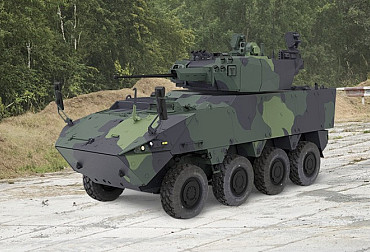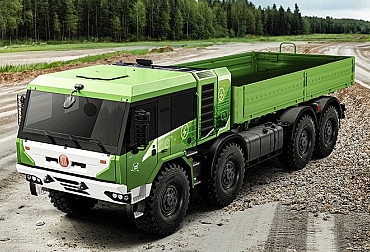British expansion of anti-tank capabilities as inspiration for the Czech Army
The United Kingdom introduced requirements for the anti-tank capabilities of the British Army of the future. The main features of the Battle Group Organic Anti-Armor (BGOAA) project are the effort to reduce costs through the use of existing and promising platforms, high mobility for future British troops and the integration of proven weapon systems. I will try to describe the extent to which the Czech Army can be inspired by the above-mentioned project in the following article.
The BGOAA project is in its infancy, but it is already a very promising project that aims to connect older anti-tank systems with current platforms. The main reason for launching this project is the proliferation of armored vehicles in less developed countries and, according to British officials, another reason is the "return of rivalry between the great powers". By this is meant Russia and China. Both countries have large numbers of tanks and other armored vehicles. As a reminder, after 2014, the 1st Guards Tank Army, numbering 600-800 tanks, was established in the Russian Western Military District. Russia in general still relies on ground forces, especially tanks supported by artillery.
 Picture: As part of the BGOAA program, the British Army is developing several options for the deployment of anti-tank missile controls. These are locations on Boxer vehicles (pictured), Ajax, on a truck and also on a unmanned ground vehicle. | MBDA / CC BY-NC-ND
Picture: As part of the BGOAA program, the British Army is developing several options for the deployment of anti-tank missile controls. These are locations on Boxer vehicles (pictured), Ajax, on a truck and also on a unmanned ground vehicle. | MBDA / CC BY-NC-ND
We could see the advantages of anti-tank guided missiles, for example, in the conflict over the Nagorno-Karabakh region, where anti-tank missiles, especially the Israeli Spike, were widely used. At that time, Azerbaijan was able (not only) to eliminate Armenian armored vehicles with the help of anti-tank missiles. In the event of a conflict between NATO and Russia, it will be crucial for NATO to destroy Russian armored vehicles and artillery. However, missiles can also be used to strike hardened ground targets. Some missiles, such as the American Hellfire, can also be used against slow-flying targets, such as helicopters or drones. The Hellfire missile is the basis of the new American IM-SHORAD mobile air defense system. Let us remind you that the Czech Army uses Spike missiles on Pandur II vehicles and also counts on anti-tank missiles for the new IFV. This means that the Czech Army certainly does not intend to get rid of this category of weapons. The BGOAA project offers the Czech Army an inspiration on how to continue developing anti-tank capabilities. The project deals with the placement of anti-tank missiles only on land vehicles, as their placement on drones and helicopters is a common practice in the British Army.
As part of the BGOAA program, the British Army is developing several options for the deployment of anti-tank missile controls. These are locations on Boxer, Ajax, truck and unmanned land vehicle vehicles. All these categories of vehicles exist in the Czech Army.
In the first case of the Boxer vehicle, it is a similar vehicle to the Pandur used in the Czech Army. In this case, we can consider two placement options. The first is the placement of missiles on a vehicle modeled on the Polish Otokar Brzoza project. The second option is to place Brimstone missiles in the rear of the vehicle and their vertical firing over long distances. The advantages of being located on Pandur are clear - easy transport of the vehicle by air, chances for the home defense industry and a proven platform.
The second option within the BGOAA is to place anti-tank missiles on a tracked Infantry Fighting Vehicle. However, this is not a "classic" location of missiles in the turret of the vehicle. The whole vehicle serves only as a carrier for the launcher. However, this variant is the least probable for the Czech Army. As part of the acquisition of new IFVs, only seven variants are envisaged, but none of them is purely anti-tank. In addition, the whole project is significantly delayed and the greatest success would be if a new IFV was selected in the next two years. The purely anti-tank variant may therefore come into play (perhaps) after 2030.
An interesting solution within the BGOAA program is to place anti-tank missiles in a container that looks similar to classic shipping containers. This container can then be placed on a 6x6 truck. The main advantage of this solution is the price and relative simplicity. The advantage is also the relative inconspicuousness of the vehicle, as in the marching position it is difficult to distinguish whether the truck carries a classic container with ammunition or anti-tank missiles. This can be especially useful nowadays, when we analyze recent conflicts using data available from open sources such as amateur reporters at the scene of the conflict.
Another interesting variant is the placement of an anti-tank guided missile (or missiles) on an unmanned ground vehicle. The UGV-Pz vehicle is currently undergoing tests in the Czech Armed Forces. In the future, it is possible to consider the integration of anti-tank missiles on this vehicle. The main advantage of such a solution is again the price. If such a vehicle were to be destroyed or captured, it would be an incomparably smaller loss than if a tracked or wheeled IFV was destroyed or captured.
The need for anti-tank capabilities will continue to grow, given the nature of current and future conflicts. Czech Army thus has the opportunity to be inspired by the British BGOAA project. As part of the development of this type of capabilities, we do not have to focus only on units of the 4th Rapid Deployment Brigade or the 7th Mechanized Brigade. An increase in anti-tank capabilities can also be considered, for example, in the 43rd Airborne Regiment and planned vehicles in its arsenal. In an emergency, as indicated for the Hellfire missile, these solutions can be used as a means of air defense, although their capabilities in this regard are limited.





















